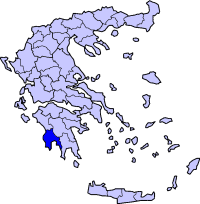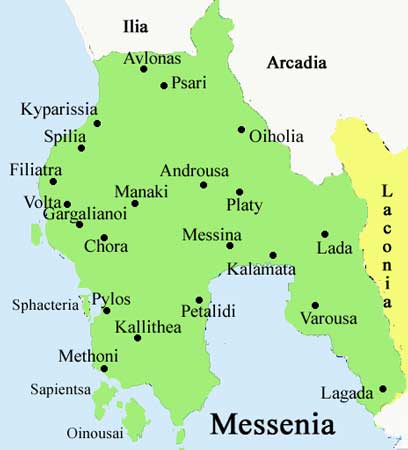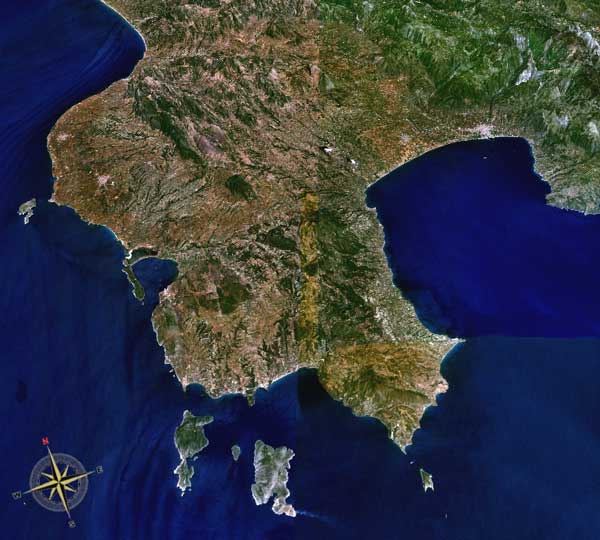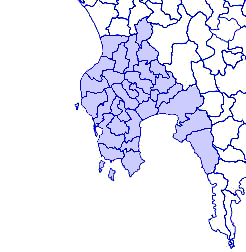.
Periphery:Peloponnese
Prefectures : Arcadia , Argolis , Corinth, Laconia, Messinia

Messinia |
 |

Messinia Satellite image
Messinia (Greek: Μεσσηνία, also spelled Messenia) is is a prefecture in the Peloponnese, a region of Greece. Messinia is bounded on the east by Mount Taygetus, on the north by the river Neda and the Arcadian Mountains, on the south and west by the sea.
History
Historically and economically its most important part is the great plain, consisting of two distinct portions, watered by the river Pamisus (mod. Pirnatza) and its affluents. This is the most fertile tract in Greece, and at the present day produces oranges, citrons, almonds, figs, grapes and olives in great abundance and of excellent quality. The plain, is bounded on the north by the Nomian Mountains (modern Tetrási, around 1,570 m, 5210 ft.) and their westerly extension, on the west by the mountains of Cyparissia (around 1,300 m, 4000 ft.), a southern continuation of which forms the south-west peninsula of the Morea, attaining its greatest height in Mt Mathia (mod. Lykódimo about 950 m, 3160 ft.). Off the south coast of, this peninsula lie the three, Oenussae islands and the islet of Theganussa (Venetikó). In spite of its long coastline, Messenia has no good harbours except the Bay of Pylos (Navarino), and has never played an important part in Greek naval history.
The earliest inhabitants of Messenia are said to have been Pelasgians and Leleges, of whom the latter had their capital at Andania. Then came an Aeolo-Minyan immigration, which apparently extended to Messenia, though the Pylos of Nestor almost certainly lay in Triphylia, and not at the site which in historic times bore that name. In the Homeric poems eastern Messenia is represented as under the rule of Menelaus of Sparta, while the western coast is under the Neleids of Pylos, but after Menelaus’s death the Messenian frontier was pushed eastwards as far as Taygetus. A body of Dorians under Cresphontes invaded the country from Arcadia, and, taking as their capital Stenyclarus in the northern plain, extended, first their suzerainty, and then their rule over the whole district. The task apparently proved an easy one, and the Dorians blending with the previous inhabitants produced a single Messenian race with a strong national feeling. But the fertility of the soil, the warm and genial climate, the mingling of races and the absence of opposition, combined to render the Messenians no match for their hardy and warlike neighbours of Sparta. War broke out—in consequence, it was said, of the murder of the Spartan king Teleclus by the Messenians - which, in spite of the heroism of King Euphaes and his successor Aristodemus ended in the subjection of Messenia to Sparta (c. 720 BC). Two generations later the Messenians revolted and under the leadership of Aristomenes kept the Spartans at bay for some seventeen years (648 BC—631 BC, according to Grote): but the stronghold of Ira (Eira) fell after a siege of eleven years, and those Messenians who did not leave the country were reduced to the condition of helots. The next revolt broke out in 464 BC, when a severe earthquake destroyed Sparta and caused great loss of life; the insurgents defended themselves for some years on the rock-citadel of Ithome, as they had done in the first war; but eventually they had, to leave the Peloponnese and were settled by the Athenians at Naupactus in the territory of the Locri Ozolae. After the Battle of Leuctra (371 BC), Epaminondas invited the exiled Messenians scattered in Italy, Sicily, Africa and elsewhere to return to their country: the city of Messene was founded in 369 BC to be the capital of the country and, like Megalopolis in Arcadia, a powerful check on Sparta. Other towns too were founded or rebuilt at this time, though a great part of the land still remained very sparsely peopled. But though independent Messenia never became really powerful or able to stand without external support. After the fall of the Theban power, to which it had owed its foundation, it became an ally of Philip II of Macedon and took no part in the battle of Chaeronea (338 BC). Subsequently it joined the Achaean League and we find Messenian troops fighting along with the Achaeans and Antigonus Doson at Sellasia in 222 BC. Philip V sent Demetrius of Pharos to seize Messene, but the attempt failed and cost the life of Demetrius: soon afterwards the Spartan tyrant Nabis succeeded in taking the city, but was forced to retire by the timely arrival of Philopoemen and the Megalopolitans. A war afterwards broke out with the Achaean League, during which Philopoemen was captured and put to death by the Messenians (183 BC), but Lycortas took the city in the following year, and it again joined the Achaean League, though much weakened by the loss of Abia, Thuria and Pherae, which broke loose from it and entered the League as independent members. In 146 BC the Messenians, together with the other states of Greece, were brought directly under Roman sway by L. Mummius. For centuries there had been a dispute between Messenia and Sparta about the possession of the Ager Dentheliales on the western slope of Taygetus: after various decisions by Philip of Macedon, Antigonus, Mummius, Caesar, Antony, Augustus and others, the question was settled in 25 by Tiberius and the Senate in favour of the Messenians (Tac. Ann. iv. 43).
In the middle ages Messenia shared the fortunes of the rest of the Peloponnese. It was overrun by Slavs, who have left their traces in many village names, and was one of the chief battlefields of the various powers: Byzantines, Franks, Venetians and Turks, who struggled for the possession of the Morea. Striking reminders of these conflicts are afforded by the extant ruins of the medieval strongholds of Kalamata, Coron (anc. Asine, mod. Korone), Modon (Methone) and Pylos. At the present day Messenia forms a department, now a prefecture with its capital at Kalamata.
About less than half of the population live within GR-7, in places from Allagi to S of Kalamata, along with the plain as the Kalamata-Messene metropolitan area, Peloponnese's third largest metropolitan city. Kalamata has an airport 5 km W of Kalamata. A harbor and port named from this city is not far from the downtown, originally connected with train tracks. It is one of the largest waterfront in the peninsula.
Climate
Climate may vary, in the lowlands, temperatures are a bit warmer than Athens. Snow is not common during winter months except for the mountains expecially the Taygetus. Rain and clouds are common inland.
For one day in July 2000, morning temperatures were at the 37°C point in many areas.
Population
Year Population Density
1991 167,292 - 56/km²
2001 172,875 57.7/km²
Transportation
There are four major highways in Messenia:
Greece Interstate 7, N, Cen.
Greece Interstate 9, NW, W, SW
Greece Interstate 9A, NW, N
Greece Interstate 82, SW, Cen., E
Communications
Television
Notioi Elliniki Teleorasi, lit. the Southern Greece Television
Municipalities and communities

| Municipality | YPES code | Seat |
|---|---|---|
| Aetos | 3802 | Kopanaki |
| Aipeia | 3803 | Longa |
| Andania | 3804 | Andania |
| Androusa | 3805 | Androussa |
| Arfara | 3808 | Arfara |
| Aris | 3806 | Aris |
| Aristomenis | 3807 | Aristomenis |
| Avia | 3801 | Kampos |
| Avlona | 3809 | Sidirokastro |
| Chiliochora | 3831 | Chandrinos |
| Dorio | 3812 | Dorio |
| Eira | 3813 | Neda |
| Filiatra | 3830 | Filiatra |
| Gargalianoi | 3811 | Gargalianoi |
| Ithomi | 3815 | Valyra |
| Kalamata | 3816 | Kalamata |
| Koroni | 3817 | Koroni |
| Kyparissia | 3818 | Kyparissia |
| Lefktro | 3819 | Kardamyli |
| Meligalas | 3821 | Meligalas |
| Messene | 3822 | Messene |
| Methoni | 3820 | Methoni |
| Nestoras | 3823 | Chora |
| Oichalia | 3824 | Meropi |
| Pappaflessa | 3825 | Vlachopoulo |
| Petalidi | 3826 | Petalidi |
| Pylos | 3827 | Pylos |
| Thouria | 3814 | Thouria |
| Voufrades | 3810 | Chatzi |
| Community | YPES code | Seat |
| Trikorfo | 3828 | |
| Tripyla | 3829 | Raptopoulo |
Islands
- Venetiko, southeast
- Sapientza
- Schiza, southwest. In April 19, 1991, an AB205 crashed on the island, no deaths were reported
- Sphagia/Sfagia
Provinces
Province of Kalamata - Kalamata
Province of Messene - Messene
Province of Pylia - Pylos
Province of Tryfilia - Kyparissia
| Ancient Greece
Science, Technology , Medicine , Warfare, , Biographies , Life , Cities/Places/Maps , Arts , Literature , Philosophy ,Olympics, Mythology , History , Images Medieval Greece / Byzantine Empire Science, Technology, Arts, , Warfare , Literature, Biographies, Icons, History Modern Greece Cities, Islands, Regions, Fauna/Flora ,Biographies , History , Warfare, Science/Technology, Literature, Music , Arts , Film/Actors , Sport , Fashion --- |
Retrieved from "http://en.wikipedia.org/"
All text is available under the terms of the GNU Free Documentation License


